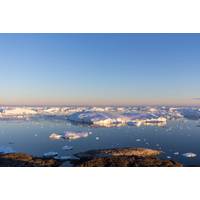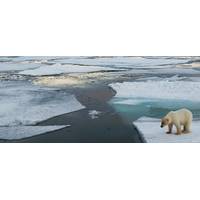
Arctic Warming Cascades Through Ocean and Over Land
said, as sunlight permeated the ocean rather than bouncing off the white surface of ice.Mean sea-surface temperatures in the Arctic Ocean in August were 1 degree to 3 degrees Celsius above the 1982-to-2010 average, the report said, with "exceptionally warm" temperatures seen in the Laptev and Kara seas off Russia early in the year."We're starting to see more of these feedbacks," Perovich told Reuters. Research on the Arctic now "is more than an intellectual exercise in understanding nature. These changes are having consequences for people living today."The warmer waters

Arctic Sea Ice Melt Continues
generally cloudy and cool. Air temperatures at the 925 hPa level were 1 to 3 degrees Celsius below the 1981 to 2010 long-term average over the eastern part of the Arctic Ocean and near average elsewhere. The cool and cloudy conditions reflect a pattern of low atmospheric pressure over the Laptev and Kara seas. As of August 16, a strong storm (central pressure of 968 hPa) was located over the Central Arctic Ocean at about 85 degrees North, near the dateline. The extent to which this strong storm will affect sea ice conditions remains to be seen, NSIDC said. Ocean heat continues ice
Billions of Juvenile Fish under Arctic Ice
used satellite data and computer models, which can retrace the slow movement of the drifting sea ice. It has long been surmised that the young fish reach the Central Arctic from their spawning grounds under drifting ice. These spawning grounds are found in the coastal waters of the Laptev and Kara Seas in northern Siberia. In autumn new sea ice forms there, and is gradually pushed northwards into open waters by the wind. The juvenile fish are assumed to travel along under the ice. “We analysed the satellite data to determine how far the ice in that particular area has travelled,&rdquo
Gazprom Building up Resource Base
(4,100 meters) resulted in a discovery of the North Rhourde Sayah field in Algeria. Key projects and regions In 2014 the main prospecting and exploration areas were the same: Yakutia, the Irkutsk Region, Sakhalin shelf, the Yamal Peninsula, the Nadym-Pur-Taz region, the Barents, Pechora and Kara Seas. According to the plans set, last year prospecting and exploration drilling exceeded 16 thousand meters of rocks, nine exploratory wells were built, and 3D seismic survey covered some two thousand square kilometers at the Chayandinskoye oil and gas field in Yakutia. At the Kovyktinskoye gas

Cooler Arctic in 2013, But Shift to Warmer State Continues
2013 was the sixth lowest since observations began in 1979. The seven lowest recorded sea ice extents have occurred in the last seven years. Ocean temperature and salinity Sea surface temperatures in August were as much as 7°F higher than the long-term average of 1982-2006 in the Barents and Kara Seas, which can be attributed to an early retreat of sea ice cover and increased solar heating. Twenty-five percent more heat and freshwater is stored in the Beaufort Gyre, a clockwise ocean current circulating north of Alaska and Canada, since the 1970s. “The Arctic Report Card presents strong

PGS, GWL Acquire Survey in Russian Barents and Kara Seas
Petroleum Geo-Services (PGS), within the framework of an international scientific program, has acquired 8,840 line km of 2D data in the Russian Barents Sea and Kara Sea. The 2D survey, conducted in partnership with Geology Without Limits (GWL), began in 2012, using the vessel Akademik Lazarev. This scientific research survey is part of a multi-year, long offset, reflection seismic program. The scope of work included increasing knowledge of the regional geology, tying the sedimentary basins, exploring interesting geological structures and identifying potential well locations in the Barents and Kara Sea

GAC Pushes Further into the Arctic with Polar Logistics Group
north. GAC Spitsbergen opened in 2010 supported by Pole Position AS, followed by a joint cooperation between GAC Norway and GAC Russia - GAC's branch in Murmansk - two years later. Also in 2012, GAC and Henriksen Shipping Service AS in Kirkenes began supporting offshore operations in the Barents and Kara seas. Last year, when the LNG carrier Ob River became the first vessel of its kind to transit the Northern Sea Route (ice-free for only two months of the year), GAC was the agent. www.gac.com



 February 2024
February 2024





